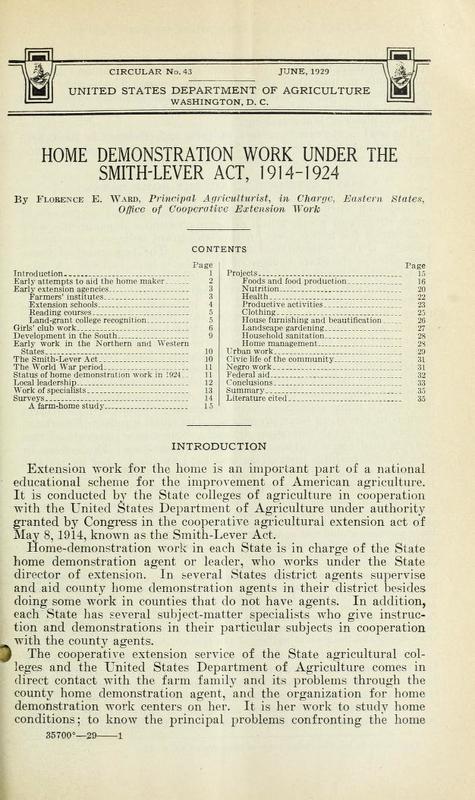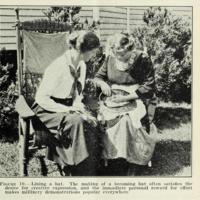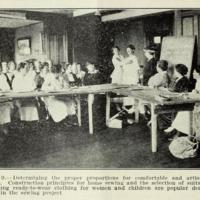Home demonstration work under the Smith-Lever Act, 1914-1924
Title
Home demonstration work under the Smith-Lever Act, 1914-1924
Creator
Date
1929
Relation
U.S. Department of Agriculture
Circular Number 43
Excerpt
A FARM-HOME STUDY
In 1919 the Office of Cooperative Extension Work, North and West, wishing to obtain information on which to base home programs, made a survey of 10,000 representative farm homes in the rural regions of the 33 Northern and Western States in cooperation with the State colleges of agriculture and the county farm bureaus, and learned from farm women themselves some of their real problems and how extension work could aid in solving them.
The 10,000 records received from farm women were obtained largely by home demonstration agents from June to October, 1919. These records exhibited the living and working conditions of the farm women and pointed to definite types of assistance which could be given through extension work in the States surveyed. To obtain reliable information on conditions, typical farming counties were chosen in each of the 33 States. In these counties certain representative communities were selected, each containing from 35 to 50 farm homes. Information was sought from every farm home in the localities selected, regardless of size, farm tenure, or the prosperity of the farm family. On some farms the telephone and the automobile had released the farm family from isolation; modern machinery had eliminated drudgery; rural engineering had provided methods of improved sanitation; and community centers had provided social contacts. Yet the survey also showed that a large percentage of farm homes had not felt the influence of these factors.
Such items as the following were brought out in the survey: The average working day, summer and winter, for 9,000 farm women was 11.8 hours; 87 per cent of the farm women reported no regular vacation during the year; 79 per cent of the women used kerosene lamps; 61 per cent carried water for household uses an average distance of 39 feet; 96 per cent did their own washing; 92 per cent did all or part of their own sewing; 32 per cent had running water in the home; 20 per cent had bathtubs; 85 per cent had outdoor toilets; 20 per cent of the farm families used automobiles; 72 per cent of the families had telephones. The average distance from the farm home to the district school was 1.5 miles; to the high school, 5.9 miles; to the church, 2.9 miles; to the family doctor, 5.7 miles; and to the hospital 13.9 miles. These percentages are based on replies received ranging from 6,500 in the case of water carried to 9,800 doing their own washing. The report of this survey was made in Department Circular 148, The Farm Woman's Problems, published in 1920.
In 1919 the Office of Cooperative Extension Work, North and West, wishing to obtain information on which to base home programs, made a survey of 10,000 representative farm homes in the rural regions of the 33 Northern and Western States in cooperation with the State colleges of agriculture and the county farm bureaus, and learned from farm women themselves some of their real problems and how extension work could aid in solving them.
The 10,000 records received from farm women were obtained largely by home demonstration agents from June to October, 1919. These records exhibited the living and working conditions of the farm women and pointed to definite types of assistance which could be given through extension work in the States surveyed. To obtain reliable information on conditions, typical farming counties were chosen in each of the 33 States. In these counties certain representative communities were selected, each containing from 35 to 50 farm homes. Information was sought from every farm home in the localities selected, regardless of size, farm tenure, or the prosperity of the farm family. On some farms the telephone and the automobile had released the farm family from isolation; modern machinery had eliminated drudgery; rural engineering had provided methods of improved sanitation; and community centers had provided social contacts. Yet the survey also showed that a large percentage of farm homes had not felt the influence of these factors.
Such items as the following were brought out in the survey: The average working day, summer and winter, for 9,000 farm women was 11.8 hours; 87 per cent of the farm women reported no regular vacation during the year; 79 per cent of the women used kerosene lamps; 61 per cent carried water for household uses an average distance of 39 feet; 96 per cent did their own washing; 92 per cent did all or part of their own sewing; 32 per cent had running water in the home; 20 per cent had bathtubs; 85 per cent had outdoor toilets; 20 per cent of the farm families used automobiles; 72 per cent of the families had telephones. The average distance from the farm home to the district school was 1.5 miles; to the high school, 5.9 miles; to the church, 2.9 miles; to the family doctor, 5.7 miles; and to the hospital 13.9 miles. These percentages are based on replies received ranging from 6,500 in the case of water carried to 9,800 doing their own washing. The report of this survey was made in Department Circular 148, The Farm Woman's Problems, published in 1920.
File(s)
Lining A Hat.jpg
(image/jpeg)
Garment Proportions.jpg
(image/jpeg)
 An official website of the United States government.
An official website of the United States government.




